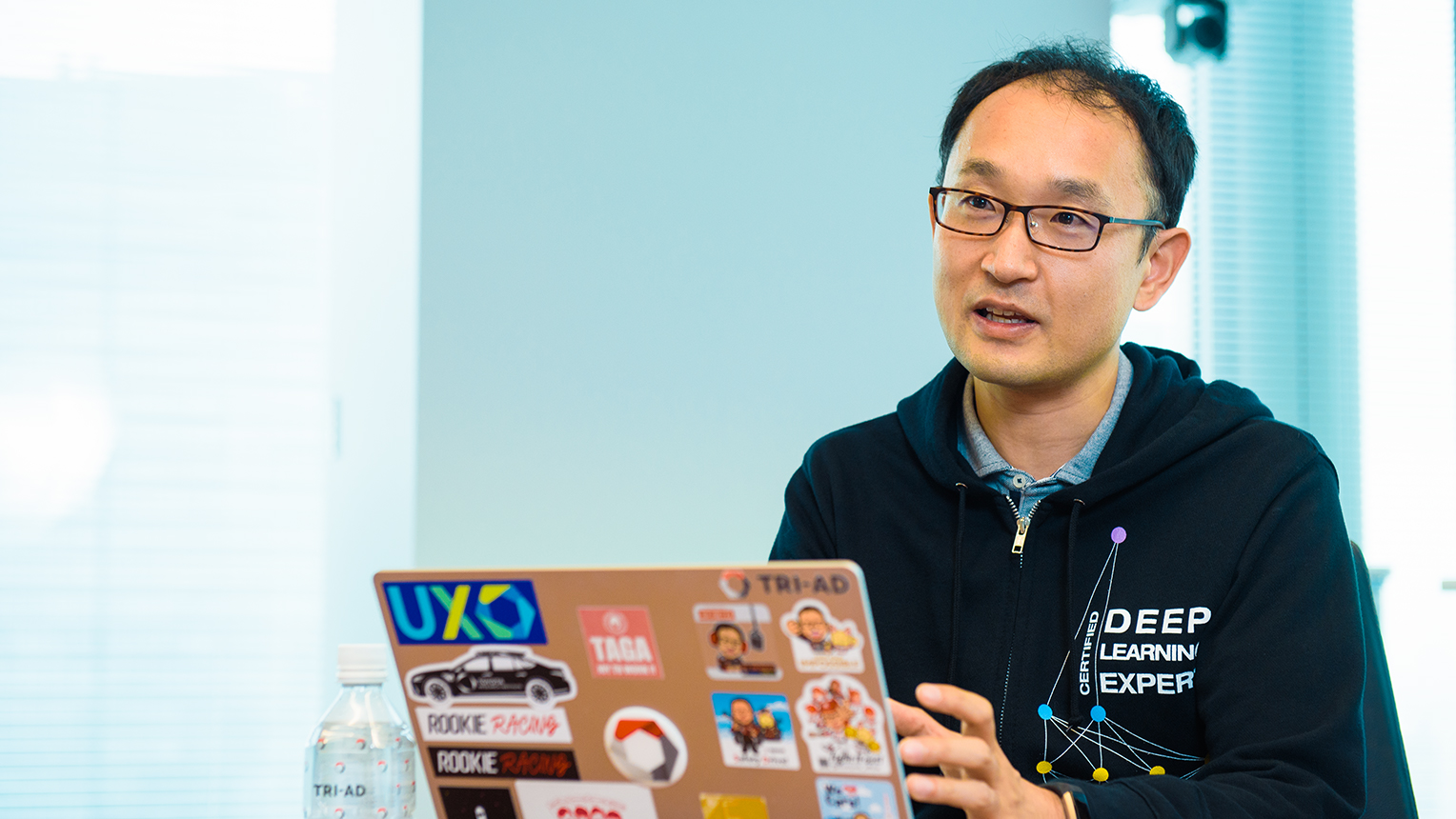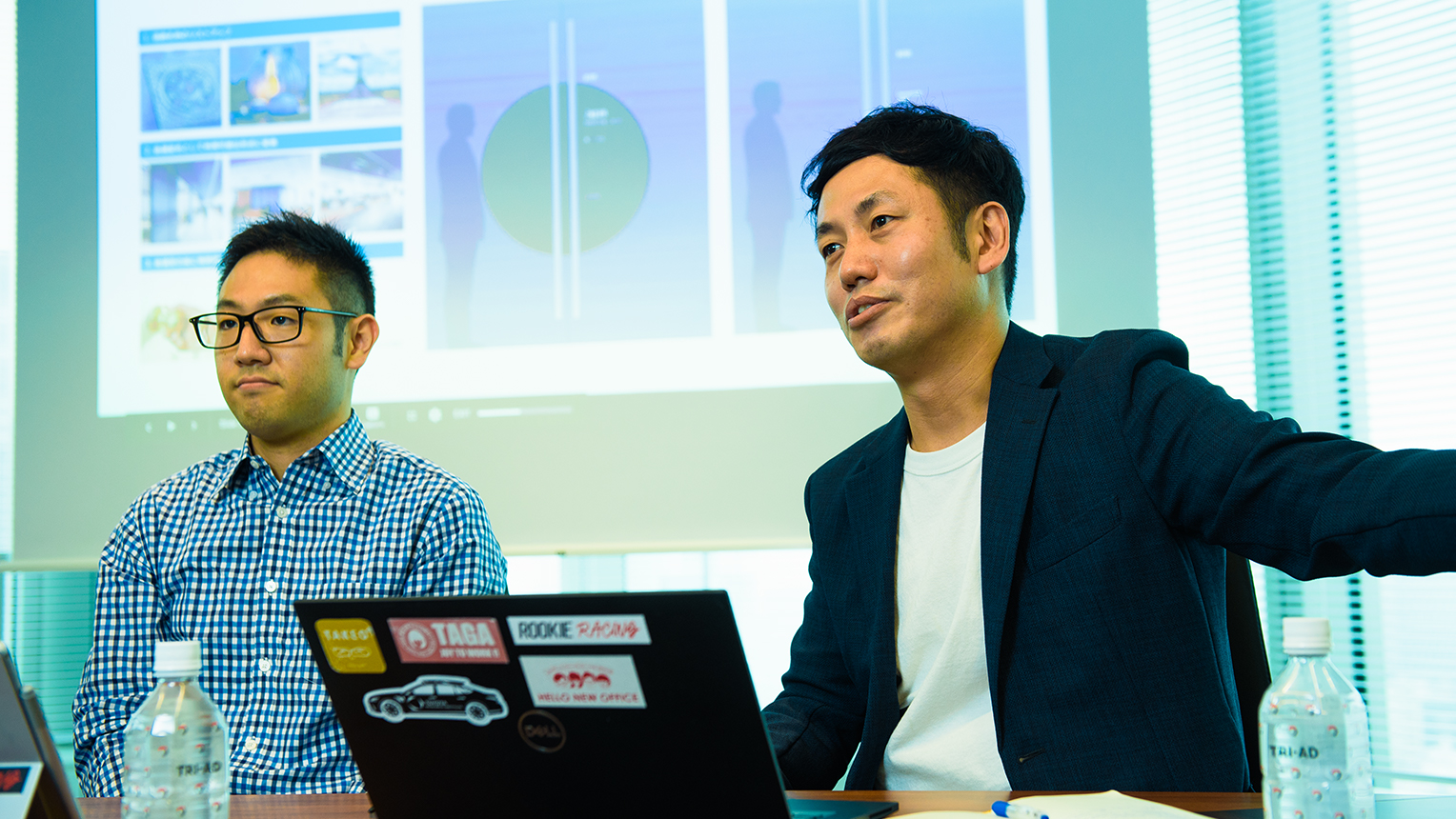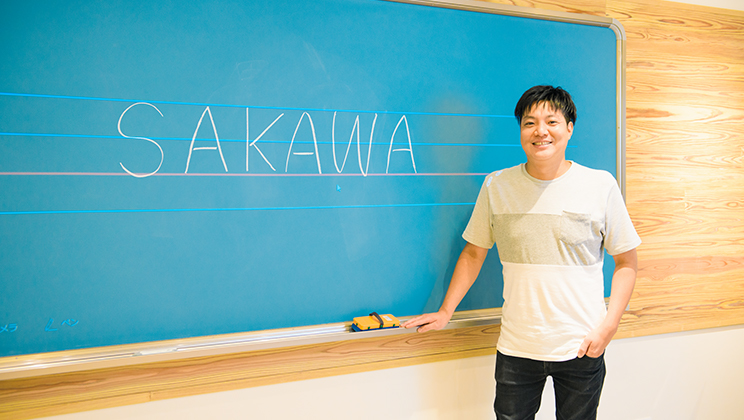TRI-AD’s Drive Towards Next-Generation Craftsmanship (Part 2) What kind of an office is one that supports a new type of work environment for engineers?
TRI-AD’s Drive Towards Next-Generation Craftsmanship (Part 2) What kind of an office is one that supports a new type of work environment for engineers?

Toyota Research Institute Advanced Development, Inc. (TRI-AD) was established in 2018 as the software development hub that supports the Toyota Group’s technologies including its automated driving technology. Bridgine has covered the efforts made by TRI-AD, which have garnered attention from various fields, in two parts. We conducted Part 2 of our interview from their newly relocated (in July) office inside the Nihonbashi Muromachi Mitsui Tower. Continuing from Part 1 of our interview, we listened in to Mr. Daisuke Toyoda (senior vice president), and core group members from the office project consisting of Mr. Takeo Iwata, Ms. Chika Harada, and Mr.Kaoru Hagimori (from Nikken Sekkei Ltd.) regarding what happened behind the scenes in designing the office that was implemented through the involvement of a variety of engineers from all around the world. We also ask about their next-generation work-style that incorporates Japanese craftsmanship with the innovative agility of Silicon Valley.
The Involvement of the Engineers in the Design of the New Office
- When TRI-AD recently relocated its office in July this year, what were you conscious about when organizing the workplace?
Toyoda: At TRI-AD, our mission is to build a bridge between the craftsmanship of Japan and advances of Silicon Valley to develop high quality software for the next generation. In order to make that possible, when we studied how to improve productivity and efficiency, it became apparent that a forcible top-down process would constrict this. To this end, we found it necessary to discuss development and working styles with engineers to help us forge forward as a company that embraces change. New office project leaders played a key role in moving the discussions forward.
Iwata: I was loaned out here from Toyota Motor Corp., and am currently working in general affairs. Initially our team consisted of 10 members, but we had to scramble frantically if we were to plan and establish a new office and working environment that was to be ready for the 300 engineers that were to arrive 3 months later. The fact that a small team could establish a company’s rules and carry out such a grand office project was only possible because we were a venture enterprise that works very closely with the management. Being affiliated with a large company, for me, was definitely a fresh and exciting challenge.

Mr. Takeo Iwata, Manager of the “Tech. Admin. & General Affairs” department in charge of general affairs for TRI-AD.
Harada: I had previously worked in HR for new recruits, but became involved in general affairs after joining TRI-AD. In addition, everything for me was a first time experience, from helping to start up a new company to the design of the office itself. For this office project, I worked on implementing the “Hello New Office” workshops to build an office environment with everyone, that everyone could enjoy. To help me achieve this, I set about making inquiries among the engineers, who would be working here, to ascertain what they would want to do or what they wished to accomplish. I communicated directly with all the engineers and listened in on their various wants and worries. After sharing these within the team, I was responsible for communicating this to the management, like a bridge-maker of sorts.

Ms. Chika Harada, affiliated with the “Tech. Admin. & General Affairs” department.
Hagimori: Although I work in architectural design at Nikken Sekkei Ltd., I joined the team as a consultant for spatial design and project promotion. With regards to the office, I know that there are many cases where space is not effectively utilized no matter how much one prepares. This happens often in situations where there is a gap between the people who build the space and the people who use the said space. The same can be said about urban development. I believe that having the residents themselves take responsibility in considering their own comfortable living environment will lead to spatial sustainability. This project is a prime example of this. By conducting numerous discussions with the architectural and IT members from Toyota Motor HQ and the project team from Nikken Sekkei, I was excited to study and learn about how an ideal office space could be achieved.

Mr. Kaoru Hagimori (right) from Nikken Sekkei. Ltd. who joined the team as a consultant on spatial design, and Mr. Daisuke Toyoda (left), senior president of TRI-AD.
Iwata: One large theme we had was to create a workplace that would entice any quality engineer anywhere to want to work here. Of course, trying to go head-to-head with one of the companies of GAFA would be difficult from a funding perspective. So instead of attempting to duplicate the companies in Silicon Valley, we instead focused on how we could incorporate the good aspects of Japanese corporate culture. In addition, I felt that having the general affairs department take the lead in preparing an office for the engineers would result in dissatisfaction. So we decided to take an approach that only a small-sized enterprise could do and involved the engineers in the design of the new office.
Toyoda: As a test driver I used to be involved in work that evaluated cars, and Toyota Motors placed importance on 3 “tastes” front, middle, and after; as evaluation milestones. The “front-taste” determines whether or not you want to get in the car upon initial viewing. The “middle-taste” determines how much you will want to continue driving in the car. Finally, the “after-taste” determines how good or bad the car was after you have finished driving. Even during the design of our new office at TRI-AD, we were conscious about all these “tastes.” The “front-taste” is the feeling of wanting to work at this company, the “middle-taste” is the feeling of wanting to continue working in this environment, and the “after-taste” is the feeling of wanting to come back to work the next day.


Volunteers from the entire company, many of whom were engineers, were invited to the “Hello New Office” workshops held 4 times on a variety of themes to be discussed.
A Workplace Conducive of Diverse “WISHES”
- How was the new office design workshop process handled?
Harada: We invited applicants and held a total of 4 workshops since February of this year. At the start of the workshop, mentioned earlier, there was a total of 339 “WISHES (things everyone wishes to accomplish)” gathered from all of the employees. We then stratified them into 11 categories such as “Collaboration,” “Focus,” “Relaxation,”“Health,” “Learning,” etc. This was actually quite difficult (laughs). From there in, we then refined each category into specific activities. In order to help visualize everything, we then made posters of the workshops that addressed these.

Posters were created to visually express the themes extracted through the workshops.
Iwata: As you may know, engineers and management may think quite differently. So there were many ideas that were generated, such as to “build a laboratory-style test site inside the office” or “run small, automated driving mobile devices around the office,” etc. These were all very interesting. This was especially prevalent among the engineers from overseas. They actively participated and talked about the various ideas they had and things they wanted to accomplish.
Hagimori: Looking at the resulting “WISHES” that were generated, instead of just one major trend, it was clear that there was a multitude of ideas dispersed throughout. For example, interests varied widely; from a person with a particular interest in relaxation, to another who was interested in a continued focus on work. So I felt that the key was to learn how to design an office environment that grants all of their individual “WISHES.”
Toyoda: The fact is, people from various cultures are gathered from around the world here, so there will definitely be differences in cultures and preferences. In one study, it has been indicated that there are 4 phases to culture shock. First is the “Honeymoon” phase where the different culture feels fresh and new. Next comes the “Anxiety” phase where coming face-to-face with the other culture gives way to worry and irritation. We then have the “Adjustment” phase where mutual understanding takes place. Finally, the “Acceptance” phase where the culture shock is finally overcome. Some might call the final phase a “fusion of cultures,” but I feel that the word “fusion” has a nuance that standardizes the various separate individualities gathered here. I feel that rather than “fusion,” the word that best indicates what we are aiming for is “coexistence.” We feel that this word better fits our philosophy as it accepts individual personalities, creates a state of “coexistence” that makes it possible for a positive chemistry to unleash the various individual strengths.

TRI-AD’s new office, comprising of a total area of 21,500 m² across 5 floors (16F to 20F) inside the Nihonbashi Muromachi Mitsui Tower.
Office Facilities that Realize 3 Themes
- Are there any overarching concepts in the entire office that you would like to share with us?
Toyoda: The main concept is “AI PALETTE.” “AI” can mean both love (Note: ”愛 or ai” means love in the Japanese language)” and artificial intelligence, and shows that humans will be front and center no matter how much technology may evolve and spread. Not to mention, the word “PALETTE” which indicates the coexistence of various employees. So in order to realize this concept, we raised 3 themes as central core factors: “Inspiration,” “High Productivity,” and “Happy Work.” For example, an activity that may look like all play and no work could be the inspiration behind actually improving productivity. As such, a team with a sudden spark of inspiration will require an environment where they could immediately begin discussions and move forward in the development process. Furthermore, in order to create something worthwhile over the long-term, we believe that being healthy and smiling while working are a must above everything else.

The office is setup with a “street” circuit that reaches around approx. 200 meters where employees can move around freely and ride personal mobility robots like the “Winglet” or a “Segway.”
Iwata: There was mention of “all play and no work,” and at TRI-AD, we recognize the need for time to focus on raising one’s skill level. We call this “TRI TIME.” Engineers are free to do what they want or realize their dreams using this time, but there are some who use this time to improve the office environment and their working style as well. Ideas such as introducing new mobility robots like the Winglet came about because of these activities.
- Please also give us an overview of the office facilities.
Iwata: We offer a place inside the office to realize the 3 themes we just talked about. First, with regards to “Inspiration” we came up with some original ideas that would make people want to walk around the office, such as the 200-meter-long street that circles the entire floor. We were deliberately conscious of trying to induce various discoveries and points of communication within the office. As a part of this, we prepared a “Dashi Board (an ornate miniature float to display items on)” for a team to freely utilize and express their individuality, similar to a Dashi (float) used at a festival or carnival. This is to serve as an impetus of enthusiasm on seeing the activities of the other teams. The second theme of “High Productivity” is to make sure that a team can immediately start discussions on and forge forward towards an agile developmental process. We realized this by creating a honeycomb structured desk layout or “SCRUM” desks, all equipped with automatic height adjusters.

“SCRUM” makes “Agile Development” possible for the realization of quick and flexible software development.
Hagimori: As for the 3rd theme “Happy Work,” we prepared a space that can be likened to a blank canvas to serve as a “stage” for the various “WISHES” of the engineers for them to elaborately create and showcase their ideas alongside members with similar preferences. The “WISHES” of the engineers, through the workshop, were narrowed down in order to setup the office by July, but there are still so many more “WISHES” that still have yet to be materialized: most have not taken “root.” We feel it is important that we carefully grow these “WISHES” in order to continuously expand the office. In the future, these personal “WISHES” could be automatically categorized by AI, and furthermore enable employees to vote, etc. We feel that we want to build a system that prioritizes and tackles the “WISHES” that have the most approval. Moreover, although not yet complete, we are planning a December launch of places that support even more freedom at work such as the grand entrance, a cafeteria, relaxation and refreshment spaces, etc.

A visualization of the “stage” space that will be set up to realize the various “WISHES.”
Company Culture in the Office-Building
- What are your thoughts looking back on this office project series?
Iwata: I was formally an engineer, so that is why I was surprised that the engineers from Toyota were proactive in their participation of this project. I am guessing that behind it all, the office environment and the presence of the town of Nihonbashi played a large part. I believe that being close to such an exciting environment will clearly affect the way you think and act. In that sense, it may be that the whole reason that this office project was so successful was because of the power of its location.
Toyoda: There are engineers with various backgrounds gathered here at this company. It includes members with experience at large companies in Japan such as Toyota Motor Corporation, to members from overseas such as Silicon Valley. We have a gathering of unique and individual engineers here, from ones who are skilled in logical thinking, to others that are very innovative.
I believe that such a gathering of people is extremely important, and I feel that I want to build a working environment where they can all coexist under a clear mission and theme.

Hagimori: In order to realize such an environment, I feel that workshops play an extremely important role. That is why I feel it would be positive if we can establish a process for sharing and the realization of using the workshops as a hub, from miniscule requests such as “could we have sugar here,” to “I want to realize this way of working,” and “I want to expand upon my performance.” Workshops by and large are not necessarily a fresh new methodology, but being involved in a project that brings about this much transparency in communication and sharing of equal relationship between management, engineers and general affairs is a first for me personally.
Toyoda: You might think that these workshops will gradually lose participation after numerous events, but I feel that a large part of the success of this is due to the members here and their contribution in inviting many participants throughout the company. They made an environment that is friendly towards participation at any time. Actually, the engineers who have participated in the workshops have all showed very high commitment. I am very appreciative of the fact that there are many here that would give their time and effort to this office project, even in cases where their regular work schedule is busy. As such, I feel as though there is a clear bond being established in the building of an environment that is being forged together.
Hagimori: I have not heard of any other cases where the actual people using the office were proactive in building their own work environment. I expect this place to become a truly new workplace in the future. The process for this kind of office-building takes time and effort, not to mention the fact that it does not have a clear path towards a goal. And although we continued all the way to the present day through trial and error, I feel that it was very good that we fumbled around together without a clear solution. I personally felt this to be an extremely precious experience here at TRI-AD. I believe that the culture of this company is in showing our intentions to each other and helping to improving one another, and this will most likely influence our main business in software development in a positive way. I feel there to be various joys discovered around our mission to develop the world’s safest automated driving technology, and that such joys will further enhance each of us one by one.

In Part 1, we talked with Mr. Daisuke Toyoda, the Senior Vice President about TRI-AD’s automated driving technology, as well as about the future of human mobility and its relationship with townscapes. Please be sure to see Part 1 of this article.
Interview and Article: Yuuki Harada (Qonversations) / Photos: Daisuke Okamura
Toyota Research Institute Advanced Development, Inc. (TRI-AD)
TRI-AD is a company that develops advanced software related to Toyota’s automated driving vehicles. Its missions are in creating the safest automated driving vehicle in the world and strengthening the link between research results from the Toyota Research Institute (TRI) and research and advanced development within the Toyota Group. In addition to developing software for automated driving, the company is also responsible for strengthening data handling technologies, and end-to-end processes, from research to commercialization seeing software development becoming a realization.




